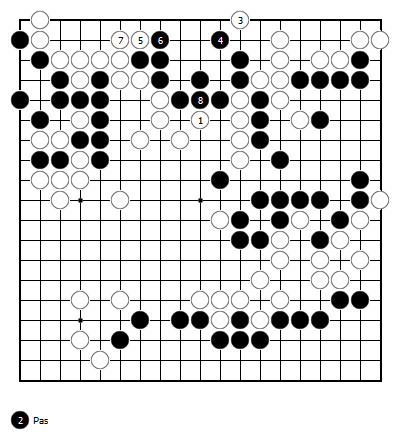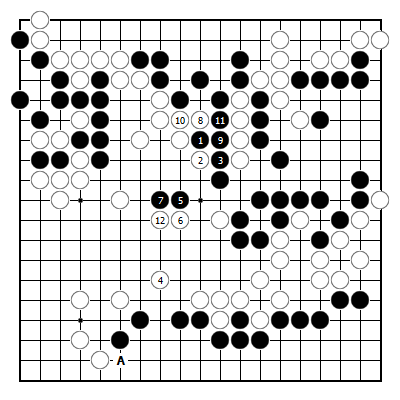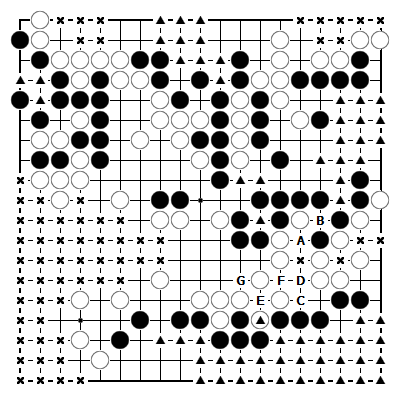TRANSLATION CONTINUEDThe capture of four stones may be big but …If White looks elsewhere …
Attachment:
 O Meien p150c.png [ 9.66 KiB | Viewed 16259 times ]
O Meien p150c.png [ 9.66 KiB | Viewed 16259 times ]
Diagram 5 (Black 2 omitted)
Diagram 5: White’s diagonal play at 1 also commands attention. This move is not just coming back to connect up his four stones; it is also promising the sente boundary plays next from White 3 to Black 8, and so in that respect it is extremely big.
Attachment:
 O Meien p151.png [ 9.7 KiB | Viewed 16259 times ]
O Meien p151.png [ 9.7 KiB | Viewed 16259 times ]
Diagram 6Diagram 6: Therefore, for Black, the move 1 to enfold the four White stones is a really big move. The block at A on the lower side is at best something like a 5-point reverse sente, and it should be apparent that in size it bears no comparison with Black 1.
I therefore wanted to play Black 1, but there was one concern. Yes, White 4, swelling his moyo in the centre, is what I feared most. In this game, the only unresolved area is the centre, and if White can puff himself up in this area it would cast a great shadow over Black’ s prospects.
Because Black can erase with something like 5 (I didn’t feel confident about intruding any further for fear of being counter-attacked), the moves up to White 12 can be expected. Let us try an evaluation of this position (see next diagram).
Attachment:
 O Meien p152.png [ 10.9 KiB | Viewed 16259 times ]
O Meien p152.png [ 10.9 KiB | Viewed 16259 times ]
Diagram 7Diagram 7: Black’s territory is marked and White’s is marked X.
As regards how to count the swathe in the lower right, we first assume that if White starts and forces with White A, Black B. If Black starts, with C, then White D, Black E, White F is forced and the cut at Black G remains, so that the territory at the triangled White stone is counted as a Black territory of 1 point. Therefore:
* Black’s territory: 69 points
* White’s territory: 67 points.
Even if we consider that next it is Black’s turn to play, we can hardly say that Black can feel confident about this position. The consequence is that capturing the four White stones with Black 1 in Diagram 6 is dubious.



